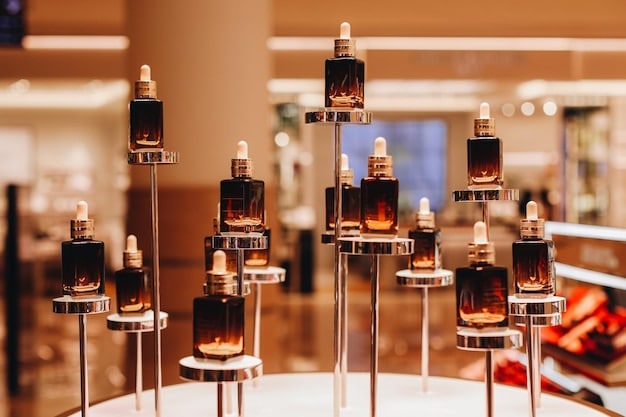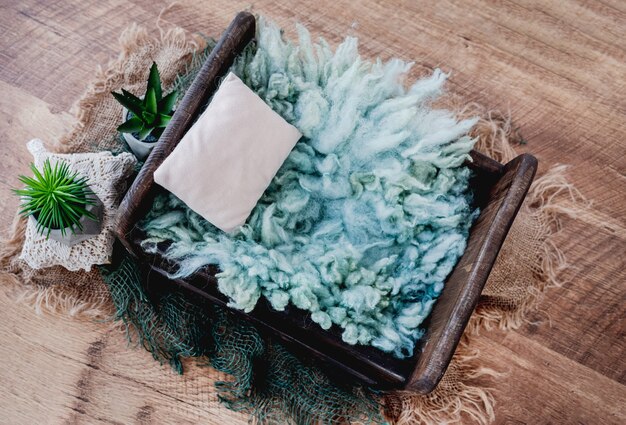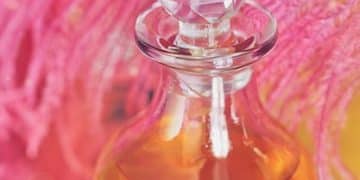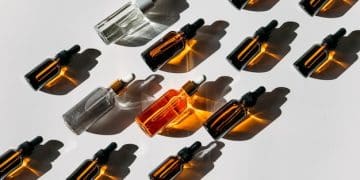Mastering Fragrance Sampling: A US Guide to Avoiding Costly Mistakes

The art of fragrance sampling in the US involves understanding how to properly test scents to make informed purchasing decisions, avoiding common mistakes such as impulse buying or relying solely on initial impressions, ultimately ensuring satisfaction and preventing regretful expenditures.
Embarking on the journey of fragrance discovery can be both exciting and overwhelming. To truly appreciate a scent and make informed decisions, understanding the art of fragrance sampling is crucial.
The Allure of Fragrance Sampling
Fragrance sampling is more than just a way to test perfumes; it’s an experience that allows you to explore a world of scents and determine what truly resonates with your personal style.
In the United States, where the fragrance market is diverse and competitive, sampling becomes an essential step in making smart purchases. It helps you avoid the costly mistake of buying a full-size bottle based solely on an initial impression or marketing hype.
The Benefits of Sampling
Sampling offers several key advantages over blind buying. It allows you to experience how a fragrance interacts with your unique body chemistry, its longevity, and its evolution over time.
- It provides a hands-on experience that goes beyond descriptions and reviews.
- You can test the fragrance in various settings and conditions.
- It helps you avoid costly mistakes by ensuring you genuinely love the scent.
Ultimately, fragrance sampling is about empowering yourself to make confident and satisfying choices. By understanding the nuances of sampling, you can build a fragrance collection that reflects your personality and style.
Where to Find Fragrance Samples in the US
Obtaining fragrance samples in the United States has become increasingly accessible, thanks to a variety of retailers and online services.
Whether you prefer the in-person experience of department stores or the convenience of subscription boxes, there are numerous avenues to explore new scents without committing to a full bottle.

Retailers and Department Stores
Many major department stores, such as Nordstrom, Sephora, and Macy’s, offer fragrance samples at their perfume counters. It’s a great way to try out different brands and scents in a hands-on environment.
You can usually ask a sales associate for a small sample spray or a blotter strip to test the fragrance. Some stores may even provide complimentary sample vials with a purchase or upon request.
Subscription Boxes
Fragrance subscription boxes like Scentbird and Luxury Scent Box have gained popularity for their convenience and variety. These services send you a curated selection of fragrance samples each month.
- They offer a cost-effective way to try a wide range of scents.
- Subscription boxes often include both popular and niche fragrances.
- You can often choose fragrances based on your preferences and scent profile.
By exploring these different sources, you can diversify your sampling options and find the methods that align best with your needs and preferences.
Effective Techniques for Sampling Fragrances
To truly appreciate and understand a fragrance, you need to go beyond a simple sniff. Effective fragrance sampling involves a strategic approach that considers timing, application, and observation.
By following these techniques, you can maximize your sampling experience and make well-informed purchasing decisions.
Timing is Key
The best time to sample fragrances is when your sense of smell is at its peak. Avoid sampling immediately after eating spicy foods or when you’re experiencing allergies or a cold.
Morning is often considered the ideal time, as your nose is less fatigued and more receptive to subtle scents.

Applying the Fragrance
When sampling, avoid rubbing the fragrance into your skin, as this can alter its chemical composition and change the scent. Instead, gently spray the fragrance onto your wrist or inside your elbow.
- Allow the fragrance to dry naturally.
- Avoid applying multiple fragrances at once.
- Use fragrance-free moisturizers to ensure a neutral base.
By paying attention to these elements, you increase your chances of accurately assessing the perfume’s true character and potential.
Common Mistakes to Avoid During Fragrance Sampling
Navigating the world of fragrance can be tricky, and even the most experienced enthusiasts can fall victim to common sampling mistakes.
Avoiding these pitfalls will help you make more informed decisions and prevent costly fragrance regrets.
Overwhelming Your Senses
One of the most common mistakes is trying too many fragrances at once. Your nose can quickly become fatigued, making it difficult to distinguish between scents. Experts recommend testing no more than three fragrances in a single session.
Trying to evaluate too many scents simultaneously can lead to olfactory overload, distorting your perception and resulting in poor choices.
Relying on the Initial Impression
Fragrances unfold in layers, with top, middle, and base notes that emerge over time. Judging a fragrance solely on its initial impression can be misleading.
- Allow the fragrance to develop over several hours.
- Pay attention to how the scent evolves.
- Consider the dry-down as the most crucial phase.
By being mindful of these oversights, you can avoid common sampling mistakes and make more satisfying choices.
Understanding Fragrance Notes and Families
Delving into the world of fragrances involves understanding the complex interplay of notes and families that define a scent’s character.
Gaining knowledge of these concepts allows you to not only appreciate the artistry of perfume creation but also navigate the sampling process with greater insight.
The Pyramid of Fragrance Notes
Fragrances are composed of three layers of notes: top, middle (or heart), and base. Top notes are the initial, fleeting scents, while middle notes form the heart of the fragrance, and base notes provide depth and longevity.
Understanding this pyramid structure can help you anticipate how a fragrance will evolve over time.
Recognizing Fragrance Families
Fragrance families categorize scents based on their dominant characteristics. Common families include floral, woody, oriental, and fresh. Each family encompasses a wide range of variations and sub-categories.
- Floral fragrances often feature notes of rose, jasmine, or lily.
- Woody fragrances are characterized by scents like sandalwood, cedarwood, or vetiver.
- Oriental fragrances present rich, spicy, and warm notes.
By familiarizing yourself with fragrance notes and families, you can refine your preferences, making the sampling process more targeted and enjoyable.
Documenting Your Sampling Experiences
Keeping a fragrance journal can be an invaluable tool for anyone serious about exploring the world of scents. Documenting your sampling is a simple but powerful way to keep track of your likes, dislikes, and discoveries.
Maintaining such a log improves your ability to identify patterns, refine your preferences, and make confident purchasing decisions.
Creating a Fragrance Journal
A fragrance journal can be as simple as a notebook or a digital document. The key is to consistently record your sampling experiences.
Include the name of the fragrance, the date you sampled it, and your initial impressions. Note the different phases of the scent and how it made you feel.
Using a Rating System
Develop a rating system to quickly evaluate fragrances. Use a scale of 1 to 5, or create custom labels like “love,” “like,” “neutral,” “dislike,” and “hate.”
- You can add detailed notes about the specific qualities you liked or disliked.
- Refer back to your journal to track your changing preferences.
- This information becomes invaluable.
By documenting your sampling experiences, you transform yourself from a casual sampler into a knowledgeable enthusiast.
| Key Point | Brief Description |
|---|---|
| 🧪 Sampling Benefits | Avoid costly blind buys, experience scent evolution, and match fragrances to your body chemistry. |
| 🏢 Sample Sources | Check department stores, retailers, subscription boxes, and online fragrance communities. |
| 👃 Sampling Techniques | Sample when fresh, spray on the skin, and allow the scent to evolve naturally. |
| 📝 Documentation | Keep a fragrance journal with notes and ratings for tracking and future decisions. |
Frequently Asked Questions
▼
Store fragrance samples in a cool, dark place away from direct sunlight and temperature fluctuations. This will help preserve the integrity of the scent and prevent it from degrading over time.
▼
Most vials contains enough product for several evaluations. Try to sample fragrances within 6-12 months of receiving them to experience them at their best. Over time, air exposure alters the notes.
▼
If you have sensitive skin, spray fragrances on clothing. Alternatively, apply a small amount of fragrance on a small, discreet area of your skin to test for any adverse reactions.
▼
Yes, many online retailers and fragrance communities offer sample programs or sell individual samples. Websites that specialize in niche fragrances are known for sample availability.
▼
Yes, it is perfectly acceptable to ask for samples to test fragrances. Department stores understand that sampling is part of the purchasing process and that it could lead to a future purchase.
Conclusion
Mastering the art of fragrance sampling empowers you to make informed decisions in the vast world of perfumes. By understanding where to find samples, employing effective sampling techniques, avoiding common mistakes, and documenting your experiences, you can build a fragrance collection that truly reflects your unique taste and style.





